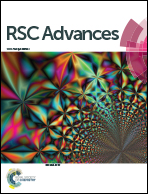Blend film based on fish gelatine/curdlan for packaging applications: spectral, microstructural and thermal characteristics
Abstract
A series of novel fish gelatine/curdlan (FG/CL) blend films at different ratios (FG/CL ≈ 10 : 0, 8 : 2, 6 : 4, 5 : 5 and 0 : 10%, w/w) were successfully fabricated at pH 12 via a casting approach, and their physico-mechanical, spectral, microstructural and thermal properties were investigated as a function of CL content. FG/CL blend films exhibited lower tensile strength (TS) but higher elongation at break (EAB) and water vapour permeability (WVP), compared to FG film (P < 0.05). Increased contact angle (θ) and moisture content (MC), but decreased water solubility (WS) were obtained for FG/CL blend films having the higher proportion of CL (P < 0.05). Furthermore, the addition of CL decreased a*-(redness) and transparency values (P < 0.05), but enhanced L*-(lightness), b*-(yellowness) and ΔE*-values (total colour difference) (P < 0.05) in FG/CL blend films. Light transmission in ultraviolet (UV) and visible regions (200–800 nm) was lowered in all FG/CL blend films, indicating excellent light barrier characteristics. Significant changes in molecular order and decreased intermolecular interactions in the matrix of FG/CL blend film were determined based on FTIR spectroscopy. TGA and DTG curves displayed that FG/CL (8 : 2) blend film had enhanced heat stability as evidenced by higher heat-stable mass residues (34.1%, w/w), compared to FG film (26.6%, w/w) in the temperature range of 50–600 °C. DSC thermogram suggested the solid-state morphology of FG/CL (8 : 2) blend film that consisted of amorphous/microcrystalline phase of partially miscible FG/CL aggregated junction zones and the coexisting of unbound CL domains. SEM micrographs elucidated that FG/CL (8 : 2) blend film was slightly rougher than FG film, but no signs of phase separation between film components were observed, thereby confirming its prospective use as food packaging material.


 Please wait while we load your content...
Please wait while we load your content...